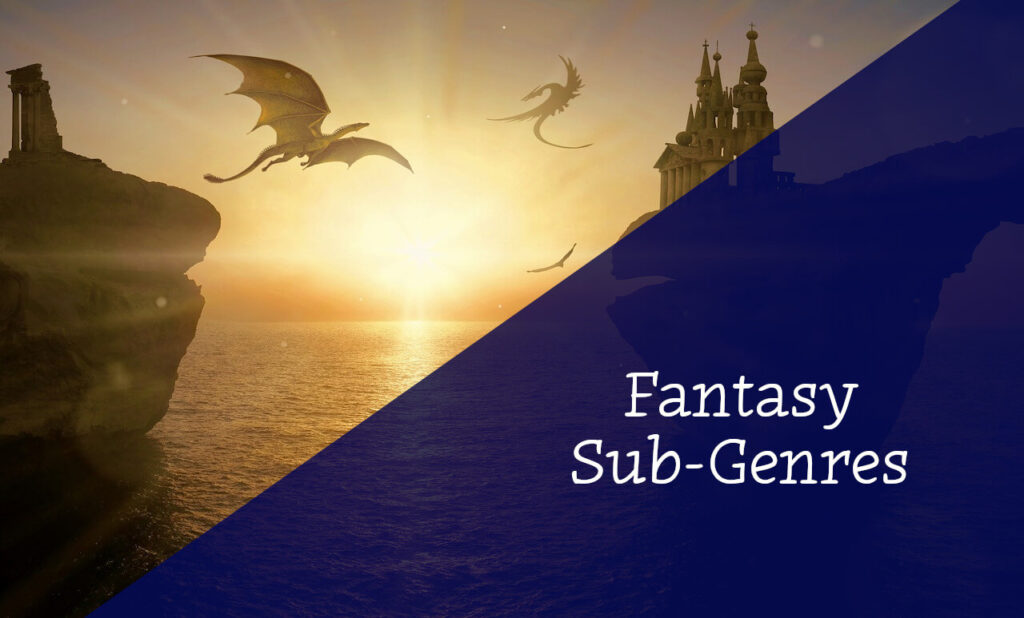As discussed previously, fantasy typically contains elements of magic and the supernatural. It can be set in “our world” with magical or supernatural rules applied to it, or it can be set in a fictional world as different from our world as the author likes. Now we’re going to look at various fantasy sub-genres.

Fantasy has many sub-genres. The following list is far from comprehensive (and the definitions are intentionally brief), but it should give you a better understanding of the more common fantasy sub-genres out there.
Contemporary Fantasy
Contemporary fantasy takes place in our current reality and deals with contemporary issues, but in this reality magic exists.
For example, The House in the Cerulean Sea by T.J. Klune, Every Heart a Doorway by Seanan McGuire, and The Ocean at the End of the Lane by Neil Gaiman.
Dark Fantasy
Dark fantasy is a blend of fantasy and horror. It uses common elements of the horror genre to set the tone but relies heavily on fantasy elements for the story’s plot.
For example, The Library at Mount Char by Scott Hawkins, Nevernight by Jay Kristoff, and Alice by Christina Henry.
Epic Fantasy
Epic fantasy takes place in a secondary world and deals with large-scale stories with high fate-of-the-world stakes.
For example, The Way of Kings by Brandon Sanderson, The Waking Fire by Anthony Ryan, and The Malazan Book of the Fallen by Steven Erikson.
High Fantasy
High fantasy is very similar to epic fantasy. It takes place in a secondary world but the stakes are smaller and focus more on the characters and setting. Magic and fantastical elements are abundant in high fantasy which means these stories contain a lot of worldbuilding.
For example, The Name of the Wind by Patrick Rothfuss, Six of Crows by Leigh Bardugo, and Strange the Dreamer by Laini Taylor.
Historical Fantasy
Historical fantasy takes place in a recognizable real world historical time period but the story is infused with magic. It mixes the historical fiction and the fantasy genres to give us an alternate and more magical/supernatural version of real events or time periods.
For example, The Bear and the Nightingale by Katherine Arden, The Golem and the Jinni by Helene Wecker, and She Who Became the Sun by Shelley Parker-Chan.
Low Fantasy
Low fantasy places less emphasis on the fantastical or magical elements of the story. It can be set on a secondary world that is similar to our world or in our world. Low fantasy focuses on the characters and their quest.
For example, The Blade Itself by Joe Abercrombie, The Lies of Locke Lamora by Scott Lynch, and Sword of Shadows by J.V. Jones.
Science Fantasy
Science fantasy is a blend of science fiction and fantasy. It has a futuristic setting with magical or supernatural elements, or it uses science or technology that is impossible in the real world given what we know.
For example, Book of the New Sun by Gene Wolfe, Red Rising by Pierce Brown, and Gideon the Ninth by Tamsyn Muir.
Urban Fantasy
Urban fantasy is a fantasy story in an urban setting. Typically, they take place set in our world but with magical rules applied to it. This is very similar to contemporary fantasy but tends to be darker, grittier, and always in an urban setting (whereas contemporary can be anywhere in our world).
For example, The Dresden Files by Jim Butcher, Magic Bites by Ilona Andrews, and Moon Called by Patricia Briggs.
Those are some of the most common sub-genres of fantasy, but there are certainly others that may not be listed here. As you’re thinking about which sub-genre your writing falls into, remember that you don’t need to narrow it down to just one. Most books fall into several different sub-genres. These are not tidy little boxes, they’re more like messy sprawling piles, and it’s not always clear where one ends and another begins.
If you have any questions about the sub-genres of fantasy or why it is important to know which category your writing falls into, leave them in the comments.
